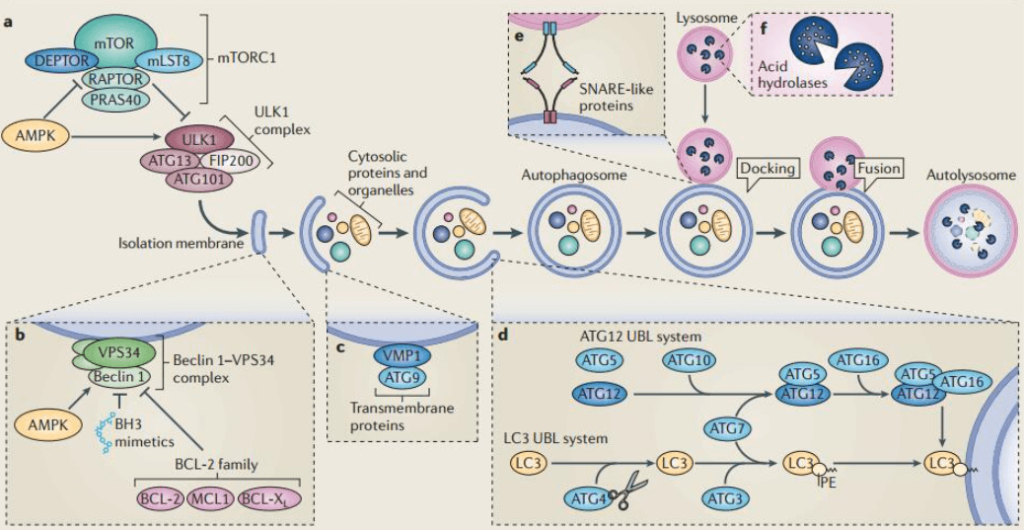Abstract: Ubiquitin is the highly conserved small molecule globular protein found in cytoplasm, nucleus and eukaryotic cell. Ubiquitination refers to the ubiquitin-protein conjugation process. Ubiquitin usually conjugates with proteins by different length, binding sites and topological structures, which results in the diversity of post-translational modifications of proteins. This process has an effect on protein stability, subcellular localization and interaction with other proteins. Currently, ubiquitination is involved in most of cellular processes, signaling pathway and regulation of diseases.
Keywords: Ubiquitination Pathway, Ubiquitination Autophagy, Ubiquitin Signaling
1. Ubiquitin-mediated Autophagy Pathway
Macroautophagy is the catabolic process where cells degrade long lived proteins, organelles and some bacteria by the lysosome. Autophagy pathway requires for the development of phagosome. The phagosome wraps cytoplasm components to form double-membrane autophagosome, and then fuses with lysosomes to digest the contents. Autophagy pathway plays an important role in protection from many diseases, e.g. neurodegeneration, myopathy, liver diseases and diabetes etc. It's reported that autophagy appears to promote and suppress cancer.
2. Beclin 1 Autophagy
Autophagy is initiated by the formation of phagosome in the PI(3)P-enriched region. Phagosome is also called omegasome. PI(3)P is produced by catalytic subunit hVps34 of Beclin 1 complex and required for recruitment of downstream autophagic components(e.g. WIPI1/2, DFCP1). ULK1/2 kinase complex (e.g. ULK1, ULK2, ATG13 and RB1CC1) is required for autophagy initiation as well, and also positively regulates Beclin 1 complex by promoting the release of Beclin 1 complex from microtubules. The direct regulation is possible by phosphorylating Beclin 1 and stimulating hVps34 activity.
3. LC3 Autophagy
The extension of phagosome requires for mATG9 and ubiquitin-like protein LC3. mATG9 mainly exits in Golgi network as a transmembrane protein and briefly interacts with phagocyte in a ulk1 dependent manner. The interaction may contribute to membrane transport during the extension of phagocyte. LC3 is converted into LC3- ii by two steps. LC3- ii is a common autophagy marker. LC3 is cleaved by ATG4B to form LC3- I. Then, LC3- I is transported to phagosome by ubiquitin-like activating enzyme ATG7 and ubiquitin-like binding enzyme ATG3, and binds with phosphatidylethanolamine(PE) to form LC3-II. The formation of LC3-II is positively regulated by effect protein PI(3)P (e.g. WIPI1/2) and ubiquitin-like complex ATG16L-ATG5-ATG12. RB1CC1 may interact with ATG16L. ULK1/2 kinase complex may play a role in the extension of phagocyte. LC3-II binds with substrates to perform autophagic degradation by different adaptor proteins. During mitochondrial autophagy, LC3-II binds with mitochondrion by BNIP3L adaptor protein.

4. Autophagy in Lysosomes
The autophgosome is formed by the double-membrane autophagosome. But the mechanism is unclear. GATE-16 is closely related to LC3 and just required after maturation of autophagosome. It may play a role in the fusion of membrane. When autophgosome fuses with lysosome, the degradation of autophgosome results in the damage of membrane and digestion of contents.
5. Recommended Antibodies
- 【FNab00860】anti- Beclin 1 antibody
- 【FNab10414】anti- Beclin 1 antibody
- 【FNab10873】anti- Beclin 1 antibody
- 【FNab09437】anti- VPS34 antibody
- 【FNab09438】anti- VPS34 antibody
- 【FNab00805】anti- Barkor antibody
- 【FNab00806】anti- Barkor-Specific antibody
- 【FNab09427】anti- VPS15 antibody
- 【FNab00669】anti- ATG16L1 antibody
- 【FNab00677】anti- ATG5 antibody
- 【FNab00678】anti- ATG5 antibody
- 【FNab00666】anti- ATG12 antibody
- 【FNab00667】anti- ATG12 antibody
- 【FNab10376】anti- ATG12 antibody
- 【FNab00668】anti- ATG13 antibody
- 【FNab00679】anti- ATG7 antibody
- 【FNab00673】anti- ATG3 antibody
- 【FNab00674】anti- ATG4B antibody
- 【FNab09251】anti- ULK1 antibody
- 【FNab00894】anti- Bif-1 antibody
- 【FNab00356】anti- AMBRA1 antibody
- 【FNab07143】anti- RB1CC1 antibody
- 【FNab07144】anti- RB1CC1 antibody
- 【FNab07146】anti- RB1CC1 antibody
- 【FNab04716】anti- Cleaved LC3 antibody
- 【FNab04719】anti- LC3A-Specific antibody
- 【FNab04717】anti- LC3 antibody
- 【FNab04720】anti- LC3B-Specific antibody
- 【FNab03277】anti- GABARAPL2 antibody
- 【FNab03278】anti- GABARAPL2-Specific antibody
- 【FNab10879】anti- ATG9A antibody
- 【FNab10883】anti- ATG4A antibody
- 【FNab10884】anti- ULK2 antibody
REFERENCES
[1]A Diversity of Selective Autophagy Receptors Determines the Specificity of the Autophagy Pathway, PMID: 31585693.
[2]The ubiquitin kinase PINK1 recruits autophagy receptors to induce mitophagy, PMID: 26266977.
[3]The Role of Ubiquitin-Proteasome Pathway and Autophagy-Lysosome Pathway in Cerebral Ischemia, PMID: 32089771.
